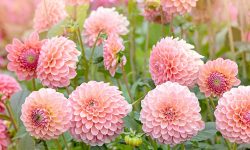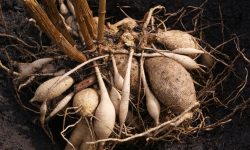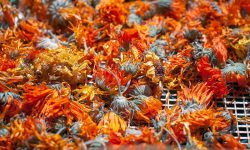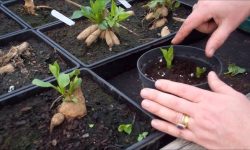Gladiolus flowers bring bold color and elegance to any summer garden. Their tall spikes rise proudly, each lined with trumpet-shaped blooms that open one by one. Gardeners love them for their drama and variety, with hues that range from deep crimson to soft pastels. Every stalk becomes a vibrant column of color that turns heads wherever it grows.
Many people ask how long these flowers stay in bloom. The answer depends on when you plant them, what type you grow, and how you care for them. Some varieties bloom for just a few weeks, while others offer color all season. With the right timing and maintenance, you can make gladiolus bloom longer and brighter. Their graceful form and lasting beauty reward every gardener’s effort.
Understanding the Gladiolus Bloom Cycle
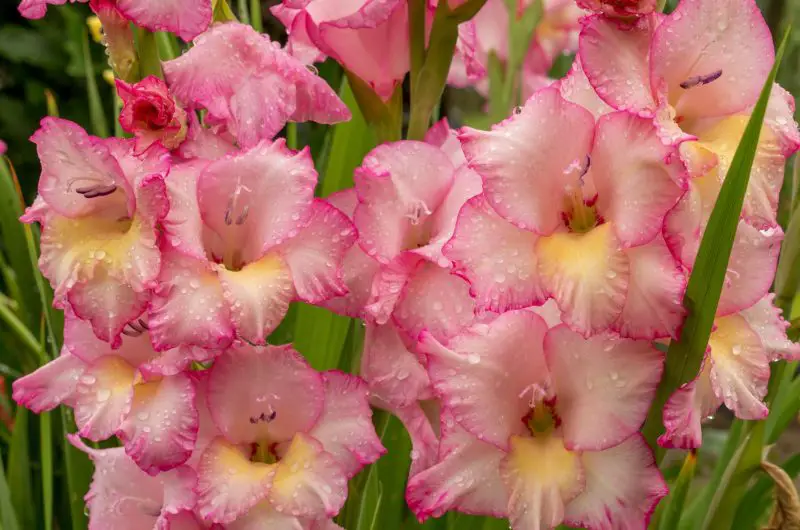
The blooming cycle of gladiolus follows a steady rhythm that reflects both environmental conditions and proper care. Each plant begins its journey as a corm, a bulb-like structure that stores nutrients for future growth. After planting, green sword-shaped leaves emerge and quickly start producing energy through photosynthesis. This energy fuels root expansion and helps the plant develop a strong base. As temperatures warm, the central stem thickens and pushes upward, forming a tall spike that holds rows of developing buds. These buds open one by one, from the bottom to the top, giving gladiolus its signature cascading bloom pattern that can last for several weeks.
In general, gladiolus plants bloom around 70 to 90 days after planting, though timing varies by region and variety. Warm climates promote faster development, while cooler or shaded areas may delay flowering. The blooming phase for each spike usually lasts two to three weeks, but careful gardeners can extend the overall display by staggering planting times every 10 to 14 days. This simple method allows continuous blooms from early summer through the first autumn frost. The color intensity and duration of the flowers also depend on soil fertility, sunlight exposure, and consistent watering.
After flowering ends, the plant redirects its energy downward to replenish the corm and form small new offsets. These offsets can be stored and replanted to grow new gladiolus the following year. Removing faded flowers and maintaining healthy foliage during this stage ensures strong corm development. Understanding each phase of the bloom cycle allows gardeners to predict bloom times, plan vibrant arrangements, and enjoy an extended season of color.
How Long Do Gladiolus Blooms Last?
Gladiolus blooms have a relatively long flowering window compared to many summer bulbs. Each spike, once it begins to open, will continue producing new blooms for about two to three weeks. The individual flowers open sequentially from the bottom upward, with each blossom lasting three to five days before wilting. This gradual blooming process gives the plant an extended display period, especially when multiple spikes appear at different times. A single gladiolus bed can remain colorful for over a month if managed well, depending on the number of plants and their planting schedule.
Bloom longevity also depends on several key factors such as temperature, light, and watering habits. In regions with moderate summer temperatures and consistent moisture, flowers tend to last longer. Excessive heat or drought conditions can shorten the blooming period by causing the petals to fade or dry out prematurely. Gardeners who water deeply, maintain soil moisture, and provide support for the tall stems often enjoy blooms that remain fresh longer. Deadheading spent flowers quickly also encourages continued blooming on remaining spikes.
Another factor influencing bloom duration is planting depth and timing. Gladiolus planted in succession—every two weeks during spring—will bloom at staggered intervals, creating waves of color from early summer through fall. Each planting group adds new spikes as the previous ones fade, maintaining constant visual interest. By choosing varieties with different bloom times and following proper care routines, you can extend the life of your gladiolus display for several months, turning a short season of color into a long-lasting floral show.
Factors That Affect Gladiolus Bloom Time
Climate and Temperature
Climate strongly influences the blooming schedule of gladiolus plants. These flowers grow best in warm, mild weather where daytime temperatures stay between 70°F and 85°F (21°C–29°C). In cooler regions, gladiolus takes longer to mature, often delaying the appearance of flower spikes by several weeks. Extreme heat can also shorten the blooming period because it causes water loss and petal dehydration. The ideal balance between warmth and consistent moisture allows each bud to open fully and last longer. Stable weather patterns lead to stronger, taller spikes and richer colors that persist through the season.
Frost, cold winds, or sudden temperature drops can stop the flowering process entirely. In northern climates, gardeners should plant gladiolus after the danger of frost has passed. In southern or tropical areas, partial afternoon shade helps reduce stress caused by scorching sun. Mulching around the base helps regulate soil temperature and retain moisture. By adjusting planting times according to climate, gardeners can ensure consistent blooming and prolong the visual impact of their gladiolus beds.
Soil and Water Conditions
Soil quality has a major impact on how well gladiolus plants bloom and how long their flowers last. Gladiolus thrives best in loose, well-draining soil enriched with organic compost or aged manure. Such soil promotes strong root growth and prevents standing water that leads to rot. Heavy clay soils trap moisture, suffocating the corm and reducing bloom duration. Gardeners should loosen compacted areas and mix sand or perlite to improve aeration. Soil fertility is equally important because nutrient-poor soil produces weak spikes and dull-colored petals. A slightly acidic pH between 6.0 and 7.0 gives gladiolus the best nutrient absorption rate for steady, vibrant flowering.
Water management plays a crucial role in bloom longevity. Gladiolus prefers consistent, deep watering—about one inch weekly—especially during dry or windy weather. Uneven watering stresses the plant, causing buds to drop before opening. Mulching around the base helps retain moisture, moderate soil temperature, and suppress weeds that compete for nutrients. However, overwatering should be avoided since soggy conditions invite fungal diseases like root rot. When moisture levels remain balanced, the plant develops healthy roots, strong stems, and long-lasting blossoms that hold their beauty for weeks. Proper soil care and hydration create the foundation for a thriving gladiolus garden.
Sunlight and Planting Depth
Sunlight controls not only the growth but also the blooming rhythm of gladiolus plants. These sun-loving flowers require at least six to eight hours of direct light each day to produce full, colorful spikes. In shaded gardens, plants tend to stretch tall but yield fewer flowers that fade quickly. Strong sunlight fuels photosynthesis, helping the corm store more energy for prolonged blooming. Adequate exposure also enhances pigment development, making reds deeper, pinks brighter, and whites more radiant. Without enough sunlight, the plant may bloom late or not at all, reducing the entire display period.
Planting depth also plays a critical role in timing and bloom stability. A general rule is to plant corms four to six inches deep, with the pointed end facing upward. In loose sandy soil, slightly deeper planting provides better support. Too shallow, and the corm dries or tips over in the wind; too deep, and sprouting becomes delayed. Proper depth and spacing—about six inches apart—allow airflow that prevents mold and pests. Combined with full sunlight, this balance ensures steady growth and continuous flowering. When these factors align, gladiolus plants reward gardeners with taller spikes and blossoms that remain stunning far longer than expected.
How to Extend the Gladiolus Blooming Period
Extending the blooming period of gladiolus begins with strategic planting. Instead of planting all corms at once, stagger them every 10 to 14 days during the spring planting season. This technique creates overlapping bloom cycles so that as one group finishes, another begins. By late summer, the garden will still be alive with color while other plants fade. Choosing early-, mid-, and late-blooming varieties also helps maintain continuous flowering from June to October. Gardeners in warmer climates can start even earlier, while those in cooler zones can stretch the season by planting into early summer.
Consistent watering and feeding play key roles in maintaining long-lasting blooms. Gladiolus prefers moist but not soggy soil, and irregular watering often leads to bud drop or fading flowers. Deep watering encourages roots to grow downward, supporting stronger spikes. During active growth, applying a balanced fertilizer with equal parts nitrogen, phosphorus, and potassium every two weeks enhances bloom size and color intensity. Removing spent blooms promptly prevents the plant from wasting energy on seed production, allowing it to focus on sustaining open flowers and forming new buds.
Protecting gladiolus from stress also helps extend their blooming time. Tall spikes benefit from staking to prevent bending or breakage caused by wind. Adding mulch around the base maintains soil moisture and reduces temperature fluctuations. In very hot weather, providing light afternoon shade can prevent petals from scorching. With careful timing, feeding, and protection, gardeners can extend gladiolus blooms well into late summer and enjoy vibrant color long after other flowers have faded.
Caring for Gladiolus After Blooming
Deadheading and Foliage Care
After the flowering period ends, gladiolus plants enter an energy recovery phase. Removing spent blooms, a process called deadheading, helps redirect nutrients back into the corm rather than seed production. Cut the faded flower spike down to just above the leaves once all blossoms have withered. Leaving the foliage intact is crucial because it continues photosynthesis, storing sugars and energy for next year’s growth. Removing the leaves too soon can weaken the corm and reduce future flowering potential. The leaves should remain until they turn fully yellow and begin to dry naturally.
During this stage, gardeners should maintain consistent watering and ensure the soil stays slightly moist but not waterlogged. A mild fertilizer rich in potassium can help strengthen the corm for the next season. Avoid high-nitrogen fertilizers, as they promote excess foliage growth instead of corm development. Keeping the area weed-free improves airflow and prevents disease buildup. Proper post-bloom foliage care guarantees larger, healthier corms and stronger flower spikes the following year.
Digging and Storing Corms
In colder regions where frost penetrates the soil, lifting gladiolus corms after blooming is essential for survival. Wait until the leaves turn completely yellow before starting, as this signals that nutrients have moved back into the corm. Using a garden fork, gently loosen the soil and lift each plant by the base, taking care not to pierce or bruise the corms. Remove excess soil by hand and trim the stalk to about one inch above the top. Spread the corms on a screen or newspaper in a shaded, well-ventilated place for seven to ten days. This drying period allows the outer skin to toughen and prevents mold growth. After curing, remove the old, shriveled mother corm at the base and keep the new, firm one for next season.
Once dried, store gladiolus corms in mesh bags, paper sacks, or shallow boxes filled with dry peat moss, vermiculite, or sawdust. Keep them in a dark, cool space with temperatures between 35°F and 50°F (1°C–10°C). Too much humidity encourages fungus, while overly dry air can cause shrinkage. Check the corms monthly for soft spots or signs of rot. Discard any infected ones immediately to prevent contamination. Properly stored corms remain viable for planting and produce strong, vibrant blooms in the next growing cycle.
Preparing for Next Season
Preparing gladiolus for the next blooming season ensures healthier plants and longer-lasting flowers. Before planting time arrives, sort through stored corms and inspect them carefully. Choose those that feel heavy, firm, and show tiny buds forming on top. Discard any soft, moldy, or damaged bulbs since they rarely recover. To restore soil fertility, rotate planting areas each year. Growing gladiolus in the same spot repeatedly can lead to nutrient depletion and fungal diseases like Fusarium rot. Amending the soil with compost or well-rotted manure helps restore nutrients and improves drainage, giving new corms the best start possible.
In frost-free zones, gardeners can leave corms in the ground over winter. However, applying a thick mulch layer—around four inches—protects them from cold snaps and preserves moisture. In spring, remove the mulch gradually to allow new shoots to emerge. For propagation, collect small cormels that form around the base of mature corms. Plant them in a separate bed where they can mature for one or two years before flowering. This natural multiplication process ensures a continuous supply of vigorous plants. By following these steps, gardeners enjoy more abundant and colorful blooms year after year.
Best Time to Plant Gladiolus for Extended Blooming
Timing is one of the most important factors in achieving long-lasting gladiolus blooms. The key to continuous color lies in succession planting rather than setting all corms at once. By planting new batches every 10 to 14 days from early spring to midsummer, gardeners can create a layered blooming effect that lasts for months. In regions with mild climates, the first planting can begin as soon as the soil warms to 55°F (13°C). In cooler northern zones, it’s best to wait until after the final frost date to prevent damage to young shoots. This staggered schedule ensures that new flower spikes appear just as earlier ones start to fade, keeping your garden in constant color.
The exact timing also depends on local conditions. In warmer southern areas, gladiolus can continue blooming into late October if planted through early summer. Meanwhile, in regions with shorter seasons, early-flowering varieties should be chosen to make full use of available warmth and daylight. Soil temperature, moisture, and sunlight all influence how quickly corms sprout and grow. Planting them too early in cold, wet soil can delay germination or cause rot, while planting too late shortens the flowering window. Proper timing provides strong root systems and vigorous spikes that hold their color longer.
To extend the bloom even further, pair your planting schedule with consistent maintenance. Apply a balanced fertilizer before flowering begins and maintain even soil moisture to support healthy bud development. Avoid overfertilizing early, which can create lush foliage but fewer flowers. Staggered planting depth—ranging from four to six inches—also helps spread bloom timing slightly. With thoughtful planning and regular care, gardeners can enjoy vibrant gladiolus displays stretching from early summer well into the crisp days of autumn.
Choosing the Right Gladiolus Varieties for Long-Lasting Color
Selecting the right gladiolus varieties can dramatically influence how long your garden stays colorful. Different cultivars bloom at varying times—early, mid, or late season—and combining them ensures a longer display. Early-blooming types like Gladiolus nanus or “Atom” produce flowers in about 65 to 75 days after planting. Mid-season varieties such as “Priscilla” and “Rose Supreme” extend the bloom period into midsummer, while late-season cultivars like “Green Star” or “Black Beauty” continue the show into early autumn. Mixing several bloom-time categories provides a seamless progression of color without long gaps between flowering stages. This variety-based approach is one of the most effective ways to maintain continuous beauty in your gladiolus garden.
Color selection also matters for visual rhythm. Pairing soft pastels with deep jewel tones enhances depth and contrast, keeping the garden visually appealing as older blooms fade. Taller hybrids, which can reach four to five feet, are excellent for creating background layers, while dwarf varieties like Gladiolus colvillei bring early bursts of color at the front of borders. The combination of heights and hues prevents monotony and allows gardeners to experiment with texture and dimension throughout the season. Choosing heat-tolerant cultivars for warm regions and cold-hardy ones for northern zones also ensures steady, reliable blooming under local conditions.
Many modern hybrids are bred for extended bloom time and resistance to disease. Varieties labeled as “long-lasting” or “extended-blooming” tend to hold their flowers several days longer than traditional types. For gardeners growing gladiolus for cut flowers, choosing varieties with strong stems and dense flower spacing ensures longer vase life as well. By selecting diverse, climate-suited cultivars, you can transform a short-lived display into months of vibrant, continuous color both in the garden and indoors.
Fertilizing and Feeding Gladiolus for Maximum Bloom Duration
Proper fertilization is one of the most powerful tools for extending the bloom period and enhancing the vibrancy of gladiolus flowers. These plants are heavy feeders that depend on nutrient-rich soil to produce tall, healthy spikes. Before planting, enrich the bed with compost or aged manure to create a fertile foundation. Applying a slow-release, balanced fertilizer—such as a 10-10-10 or 5-10-10 ratio—provides steady nourishment throughout the growing season. The higher phosphorus content supports strong root development and promotes abundant flowering, while moderate nitrogen prevents excessive leaf growth. Working fertilizer into the top few inches of soil ensures nutrients are available to developing roots.
Once gladiolus shoots emerge, consistent feeding maintains energy for continuous blooming. Apply a liquid fertilizer every two to three weeks during the active growth phase. Organic options like seaweed extract or fish emulsion deliver trace minerals that strengthen the plant’s immune system and enhance petal intensity. Water the plants thoroughly after each feeding to prevent fertilizer burn and help nutrients reach the root zone. Avoid high-nitrogen lawn fertilizers, as they tend to produce lush foliage at the expense of flowers. During the flowering stage, switch to a bloom booster with higher potassium levels to encourage longer-lasting, more colorful blooms.
As the flowering season nears its end, reduce feeding to allow the plant to redirect energy into the corm. This post-bloom nutrient storage strengthens the bulb for the next growing cycle, ensuring vigorous shoots and earlier blooms the following year. Well-fed gladiolus plants not only bloom more profusely but also maintain flower freshness longer. Balanced fertilization, paired with good watering and sunlight, forms the foundation for a healthy, extended display of brilliant gladiolus color throughout summer and beyond.
Common Problems That Affect Gladiolus Blooms
Pest Infestations
Pests are among the most common reasons gladiolus plants fail to bloom properly or lose their flowers early. Thrips, small sap-sucking insects, are particularly destructive, feeding on buds and petals and leaving behind streaks or brownish scars. Heavy infestations can distort blooms and stunt overall growth. Aphids and spider mites also cause stress by draining plant fluids, leading to curled leaves and reduced flowering power. Regular inspection of the leaves and flower spikes helps detect these pests early before serious damage occurs. In severe cases, untreated infestations can destroy entire patches of gladiolus.
To control pests effectively, start by maintaining good garden hygiene. Remove plant debris after flowering to eliminate overwintering insects. Spraying plants with a strong stream of water dislodges aphids and mites naturally. Neem oil or insecticidal soap is safe for both gladiolus and beneficial insects. In large gardens, rotating crops or avoiding replanting gladiolus in the same spot for several years helps break pest life cycles. A healthy, well-fed plant also resists infestations better, so proper nutrition remains essential for protection.
Fungal and Bacterial Diseases
Fungal and bacterial infections often cause wilted foliage, spotted leaves, and premature bloom decline. The most common fungal issue in gladiolus is Fusarium oxysporum, which leads to corm rot and yellowing leaves. This disease thrives in poorly drained soil and humid conditions. Another problem, botrytis blight, creates gray mold on flowers, especially during wet weather. Once these infections take hold, affected plants weaken quickly, and blooms fail to open or collapse prematurely. Preventing disease is easier than treating it once it spreads.
To minimize risk, always plant gladiolus in well-drained soil and avoid watering late in the evening. Space plants adequately to promote air circulation and reduce humidity around the foliage. Sterilize garden tools before reusing them and rotate planting locations every few years. Using fungicide dust or soaking corms in a mild antifungal solution before planting can prevent contamination. Removing and discarding infected plants immediately keeps the problem from spreading. With proactive care and clean growing conditions, gladiolus can stay healthy and bloom abundantly.
Environmental Stress and Nutrient Deficiency
Environmental stress plays a major role in poor blooming performance. Gladiolus plants exposed to extreme heat, drought, or heavy winds often develop smaller flowers or fail to bloom altogether. Sudden temperature fluctuations can shock the plant, disrupting its growth cycle. Overcrowding and lack of sunlight also reduce bloom size and color intensity. Stress weakens the plant’s ability to absorb nutrients efficiently, shortening the flowering duration. Adjusting environmental factors early ensures that gladiolus remains healthy throughout its blooming season.
Nutrient imbalance is another frequent issue. Too much nitrogen encourages excessive leaf production but reduces flower formation, while low potassium and phosphorus cause weak spikes and dull petals. A soil test before planting helps identify deficiencies and guides proper fertilizer use. Consistent watering, mulching, and balanced feeding minimize stress and help the plant recover from weather fluctuations. When gladiolus grows in stable, nutrient-rich conditions, it produces strong stems, vivid blooms, and a longer-lasting floral display.
FAQs about Gladiolus Blooming
How many times do gladiolus bloom in a season?
Gladiolus bloom once per season, but each spike produces flowers for two to three weeks. By planting new corms every two weeks in spring, you can enjoy continuous color and a steady wave of blossoms that lasts through summer and early autumn.
Why are my gladiolus not blooming?
Lack of sunlight, poor soil, or old corms can prevent blooming. Ensure at least six hours of sun daily, rich well-drained soil, and replace small or damaged corms yearly. Adding a fertilizer high in phosphorus often restores healthy, full blooms.
How can I make my gladiolus blooms last longer?
Water regularly, deadhead spent flowers, and provide afternoon shade in hot weather. For cut blooms, harvest early morning, trim stems, and refresh water daily. These small steps keep gladiolus flowers fresh for much longer in both gardens and vases.
Do gladiolus come back every year?
In warm climates, gladiolus can regrow from the same corms yearly. In colder zones, dig and store corms indoors during winter. Replant in spring for strong spikes and bright flowers season after season. Proper care makes them reliable perennials.
What is the best fertilizer for gladiolus blooms?
Use a balanced fertilizer like 5-10-10 or 10-10-10. High phosphorus and potassium strengthen stems and improve flower quality, while too much nitrogen causes leafy growth. Feed every few weeks during the growing season for long-lasting, colorful blooms.
Conclusi on
on
Gladiolus brings elegance, height, and vivid color to any summer garden. With proper timing, consistent care, and the right choice of varieties, their blooms can last for months instead of weeks. Understanding the full growth cycle—from planting to post-bloom care—ensures stronger corms and more abundant flowers each year. Regular feeding, pest prevention, and well-timed watering all help maintain long, vibrant spikes. When given the attention they deserve, gladiolus will transform your garden into a living display of color and grace, returning season after season with renewed beauty and endless charm.

